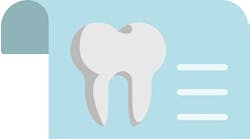It’s no secret that the quality of our health affects the quality and appearance of our teeth. Many studies have shown that the reverse is also true—the health status of our teeth can affect our health elsewhere in the body. These two things go together, it seems, like two peas in a pod.
In the dental industry, it makes sense for dentists to want their employees to exemplify the healthiest habits and to have beautiful, well-taken-care-of teeth. This sets the ultimate example for their patients. There are few things that go more against this principle than smoking. The very thought of a dental employee standing outside smoking a cigarette at the entrance of the building for all of the patients to see is like nails on a chalkboard to many dentists. It’s outrageous and unacceptable.
In addition to appearance and setting an example, employers may want to consider the fact that the US Centers for Disease Control and Prevention estimates that smoking costs American companies approximately $300 billion in health expenses and lost productivity.1 This means that, on average, smokers cost their employers nearly $6,000 a year more than staff who don’t smoke.2
What’s the cure? Is it refusing to hire someone, or even terminating someone, who has the habit of smoking? Is it really that easy? If you’ve read our articles before, you know that it is not that easy.
Roughly 29 states plus the District of Columbia have laws on the books that protect smokers. These laws vary in their protections. In general, however, they ban employers from discriminating against people for “lawful, off-duty conduct.”
These laws do have some exceptions. For example, some of the statutes apply only to employers with a certain number of employees, or to public employers. Many statutes also have exemptions where smoking would pose a safety risk to the employee or the workplace (e.g., volatile chemicals on the premises). Therefore, you’ll want to be sure you know what is and is not allowed in your state, county, or city before implementing a hiring freeze on smokers.
Thus far, it has not been successfully argued that smoking is a disability and, therefore, covered by the Americans with Disabilities Act. But that doesn’t mean this will always remain true because laws and the interpretations of those laws change. However, diseases that may have been caused by smoking are most likely covered and protected, for example, cancer and asthma.
Regardless of protections, smoking in the workplace can always be managed. For example, there is no law that requires employers to provide smoke breaks. Employers can have a policy that prohibits smoking during work hours and on the premises. Employers can manage smell (i.e., clothes and breath) during work hours, much like any other appearance standards that are required.
These rules ensure that patients are not witnesses to this type of behavior when visiting your practice. If you have any of these of rules, it is imperative that you have a policy that specifically addresses them to ensure everyone understands them and will be treated consistently. In this day and age, any rules you enforce need to cover a broad spectrum of tobacco use. For example, the rules should ban chewing tobacco, e-cigarettes (vaping), and other types of tobacco products.
You may also implement programs that encourage smokers to quit. These can include:
- On-site smoking cessation classes
- Smoking cessation counseling
- Coverage of drug therapies
- Charging smokers higher health insurance premiums
- Flexible benefit credits to finance cessation interventions
Given the myriad of potential protections and threats of challenges, employers are best served by remaining focused on job-related characteristics. Smoking is not an indicator that someone cannot perform his or her job well or be a productive, quality worker. Using nonwork-related aspects that are otherwise legal against someone in the hiring process invites lawsuits and challenges, which is clearly not in your best interest.
References
1. Economic trends in tobacco. Centers for Disease Control and Prevention website. https://www.cdc.gov/tobacco/data_statistics/fact_sheets/economics/econ_facts/index.htm.
2. Fox M. Smoking employees cost $6,000 a year more, study finds. NBC News website. https://www.nbcnews.com/healthmain/smoking-employees-cost-6-000-year-more-study-finds-6C10182631. Published June 3, 2013.
TIM TWIGG is the president of Bent Ericksen & Associates and REBECCA BOARTFIELD is an HR compliance consultant. For more than 30 years, the company has been a leading authority on human resources and personnel issues, helping dentists successfully deal with ever-changing and complex labor laws. To receive a complimentary copy of the company’s quarterly newsletter or to learn more, call (800) 679-2760 or visit bentericksen.com.






